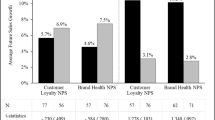Abstract
Shorter product life cycles and aggressive marketing, among other factors, have increased the complexity of sales forecasting. Forecasts are often produced using a Forecasting Support System that integrates univariate statistical forecasting with managerial judgment. Forecasting sales under promotional activity is one of the main reasons to use expert judgment. Alternatively, one can replace expert adjustments by regression models whose exogenous inputs are promotion features (price, display, etc). However, these regression models may have large dimensionality as well as multicollinearity issues. We propose a novel promotional model that overcomes these limitations. It combines Principal Component Analysis to reduce the dimensionality of the problem and automatically identifies the demand dynamics. For items with limited history, the proposed model is capable of providing promotional forecasts by selectively pooling information across established products. The performance of the model is compared against forecasts provided by experts and statistical benchmarks, on weekly data; outperforming both substantially.




Similar content being viewed by others
Notes
For instance, the temperature is a significant independent variable in the soft-drink industry as it is discussed by Divakar et al (2005).
References
Box GEP, Jenkins GM and Reinsel GC (1994). Time Series Analysis: Forecasting and Control. Prentice-Hall: Englewood Cliffs, NJ.
Caniato F, Kalchschmidt M and Ronchi S (2011). Integrating quantitative and qualitative forecasting approaches: Organizational learning in an action research case. Journal of the Operational Research Society 62 (3): 413–424.
Cooper LG, Baron P, Levy W, Swisher M and Gogos P (1999). PromoCast™: A new forecasting method for promotion planning. Marketing Science 18 (3): 301.
Davydenko A and Fildes R (2013). Measuring forecasting accuracy: The case of judgmental adjustments to sku-level demand forecasts. International Journal of Forecasting 29 (3): 510–522.
Divakar S, Ratchford BT and Shankar V (2005). CHAN4CAST: A multichannel, multiregion sales forecasting model and decision support system for consumer packaged goods. Marketing Science 24 (3): 334–350.
Fildes R and Goodwin P (2007). Against your better judgment? How organizations can improve their use of management judgment in forecasting. Interfaces 37 (6): 70–576.
Fildes R, Goodwin P and Lawrence M (2006). The design features of forecasting support systems and their effectiveness. Decision Support Systems 42 (1): 351–361.
Fildes R, Nikolopoulos K, Crone SF and Syntetos AA (2008). Forecasting and operational research: A review. Journal of the Operational Research Society 59 (9): 1150–1172.
Fildes R, Goodwin P, Lawrence M and Nikolopoulos K (2009). Effective forecasting and jugdmental adjustments: An empirical evaluation and strategies for improvement in supply-chain planning. International Journal of Forecasting 25 (1): 3–23.
Gardner ES (1985). Exponential smoothing: The state of the art. Journal of Forecasting 4 (1): 1–28.
Gardner ES (2006). Exponential smoothing: The state of the art, Part II. International Journal of Forecasting 22 (4): 637–666.
Hughes MC (2001). Forecasting practice: Organisational issues. Journal of the Operational Research Society 52 (2): 143–149.
Hyndman RJ and Koehler AB (2006). Another look at measures of forecast accuracy. International Journal of Forecasting 22 (4): 679–688.
Hyndman RJ, Koehler AB, Ord JK and Snyder RD (2008). Forecasting with Exponential Smoothing: The State Space Approach. Springer-Verlag: Berlin.
Jolliffe IT (1982). A note of the use of principal components in regression. Applied Statistics 31 (3): 300–303.
Jolliffe IT (2002). Principal component analysis, 2nd edn. Springer Series in Statistics Springer: New York.
Lawrence M, O’Connor M and Edmundson B (2000). A field study of sales forecasting accuracy and processes. European Journal of Operational Research 122 (1): 151–160.
Leeflang PS, van Heerde HJ and Wittink D (2002). How promotions work: SCAN*PRO-based evolutionary model building. Schmalenbach Business Review 54 (July): 198–220.
Makridakis S et al (1982). The accuracy of extrapolation (time series) methods; results of a forecasting competition. Journal of Forecasting 1 (2): 111–153.
Ord JK and Fildes R (2012). Principles of Business Forecasting. South-Western Cengage Learning: Mason, OH.
Özden Gür A, Sayin S, van Woensel T and Fransoo J (2009). SKU demand forecasting in the presence of promotions. Expert Systems with Applications 36 (10): 12340–12348.
Pedregal D, Contreras J and Sanchez A (2012). ECOTOOL: A general MATLAB forecasting toolbox with applications to electricity markets. In: Sorokin A, Rebennack S, Pardalos PM, Iliadis NA and Pereira MVF (eds.). Handbook of Networks in Power Systems I. Springer: Berlin Heidelberg, pp 151–171.
Sayrs L (1989). Pooled Time Series Analysis. Sage Publications: Newbury Park, CA.
Schwarz G (1978). Estimating the dimension of a model. Annals of Statistics 6 (2): 461–464.
Snyder RD, Ord JK and Beaumont A (2012). Forecasting the intermittent demand for slow-moving inventories: A modelling approach. International Journal of Forecasting 28 (2): 485–496.
Taylor JW (2011). Multi-item sales forecasting with total and split exponential smoothing. Journal of the Operational Research Society 62 (3): 555–563.
Trapero JR, Fildes R and Davydenko A (2011). Nonlinear identification of judgmental forecasts effects at SKU level. Journal of Forecasting 30 (5): 490–508.
Trapero JR, Pedregal DJ, Fildes R and Kourentzes N (2013). Analysis of judgmental adjustments in the presence of promotions. International Journal of Forecasting 29 (2): 234–243.
Trusov M, Bodapati AV and Cooper LG (2006). Retailer promotion planning: Improving forecast accuracy and interpretability. Journal of Interactive Marketing 20 (3): 71–81.
Author information
Authors and Affiliations
Rights and permissions
About this article
Cite this article
Trapero, J., Kourentzes, N. & Fildes, R. On the identification of sales forecasting models in the presence of promotions. J Oper Res Soc 66, 299–307 (2015). https://doi.org/10.1057/jors.2013.174
Received:
Accepted:
Published:
Issue Date:
DOI: https://doi.org/10.1057/jors.2013.174




